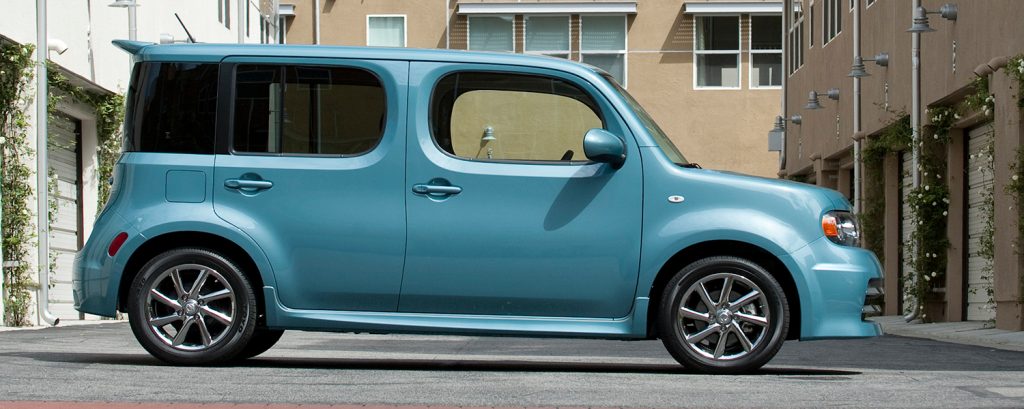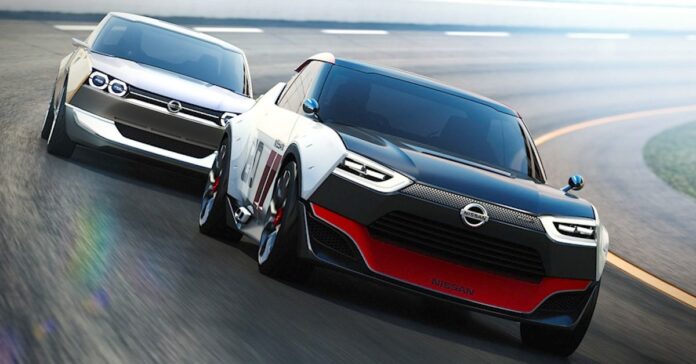Big changes are hitting the US car market this week – but uncertainty bring opportunity, and few companies have less to lose and more to gain from 2025’s automotive turmoil than Nissan. With a new, enthusiastic CEO, interest from Foxconn and Honda, and a number of American manufacturing sites already in operation, Nissan has a chance – but the new LEAF is a snoozer, and they’ll have to do better if they want to survive.
Once upon a time, a new Nissan LEAF would be the biggest news of the day – especially on an EV site. Such is the state of things in 2025, however, that an all-new Nissan LEAF reveal doesn’t even make into the day’s “Featured” stories app.
And, frankly, it’s no wonder. Back in 2021, Nissan showed its Ambition 2030 presentation. TTAC’s Matt Posky called it, “an hour of wishful thinking,” and rightly pointed out that the company had closed out 2020 with a raft of layoffs, billions in losses, and shocking build quality issues. The general consensus at the time was that if a bevy of poorly-conceived, hastily rendered CGI concepts was the best Nissan could put out, it was well and truly lost.
That was then. Now, there’s hope. The brand has nothing left to lose, and Nissan’s incoming CEO, Ivan Espinosa, spent two decades growing the brand in Mexico. And he’s not just a sports car enthusiast – but, crucially, a Nissan sports car enthusiast, with what appears to be a sincere love for classic rides like the OG Sentra SE-R, the J30 Maxima, and every proper Z and GTR that ever rolled off an assembly line.
But enthusiasts don’t buy cars. Not new ones, anyway. And new enthusiasts aren’t created at auto shows or expos – they’re created in the driver’s seat. Espinosa might understand this. And if he does, he’ll embrace these five ideas, and drive Nissan back to victory lane.
1. Ditch technology

See that? That’s a beautiful, classic Datsun 240Z interior, filled with character, natural materials, and all manner of buttons, switches, knobs, and levers. Granted, there are a lot of issues with these things, and they’re probably more expensive to produce in 2025 than the now-ubiquitous array of touchscreens, but all this physical interaction created engagement.
This isn’t an old guy waxing nostalgic about the olden days, kids – engagement is what the companies with the most fervent fanbases have, and it’s that push for engagement that has led car companies to examine the object people interact with the most (their phones), and misguidedly do everything they can to either make their cars feel more like peoples’ phones, or build cars that drive people around so they can keep interacting with their phones.
Nissan can’t build phones better than Xiaomi can build phones, Nissan doesn’t have the money to build up advanced ADAS or “self-driving” features like Tesla, and literally no one – not even Honda – has given me a good answer as to why anyone would want an AI like Honda’s new ASIMO OS in their next car.
If Nissan can’t compete, they shouldn’t try. Ditch the tech. Ditch the cost. Ditch the electronic gremlins and J.D. Power hits for glitchy OS integration. Get back to the basics of building great cars. And to build a great car, you must …
2. Simplify, and add lightness

… it was the great Colin Chapman, founder of Lotus Cars, who said that making a great car was easy. “All you have to do,” he explained, “is simplify, and add lightness.”
To be clear, Americans don’t want efficiency. Being efficient in the US, being frugal, being affordable – all of these are “bad” things in America, where bigger is better and being forced to admit that you don’t have the cash to buy a thing you want right. This. Second. is a top 5 fear.
But Lotus’ cars aren’t seen as cheap. They may be simple. They may lack some of the bells and whistles and lots of the sound deadening, ultra-high powered HVAC, and audio features of their peers, but they’ve turned those omissions into strengths, and Nissan can do the same.
After proudly ditching the phone-like tech experience, connectivity, and ADAS features, Nissan’s cars will already be simpler, more physically engaging experiences. The next move is to cut weight (and costs) by cutting features.
Power seats? Gone – replace those with high-quality, multi-adjustable lightweight seats and wrap them in high-quality materials. Massive, 20″ wheels? Get back to 16s. 18″ at the most. Ditch the center screens and radios, but include a high-quality dock for people to add their own devices for navigation and music. Sound insulation? Cut it in half. High-end audio experience? No. Ditch the space heaters and embrace more efficient heated seats and steering wheels in EVs.
Keeping things simple can be easily spun into a marketing plus, and the increased efficiency will pay massive dividends in both vehicle dynamics and range, since it simply takes fewer kW to move fewer kg. Plus: driving lightweight cars is just more fun.
3. Embrace the right to repair

Nissan’s dealers are in revolt – and for good reason: there’s just too many of them. According to some reports, the average Nissan dealer has lost 400 new car sales (annually) per store. That’s significantly higher than the industry average (86), and some 40% of the Nissan dealer body was in the red through the first six months of 2024.
There are Fiat, Mini, and Mitsubishi dealers that only do 400 units per year. Lots of ’em, in fact, and the only real way to cut those losses and save the company’s top performers is to shutter the bottom third (frankly, even that might be too many).
I’m not the only one saying this, and the problem isn’t just volume.

But where, then, does that leave Nissan’s established owner base? Not having enough dealers and service centers is a huge problem for trillion-dollar Tesla, so you can be sure that nearly bankrupt Nissan is in no position to solve the same problem.
The solution is to open up, and embrace right to repair.
Nissan, more than any other carmaker, has a huge number of relatively dependable cars already in the market and everything to gain from giving away access to those cars’ technical secrets. With relatively little effort, Nissan could release a series of online technical support materials, technician training, and more. And if Nissan gets really smart, they’ll post those classes on LinkedIn Learning, enabling professionals and hobbyists alike to complete the training and post certificates on their walls.
Imagine what that could do for a young person just getting started. Imagine what that could do for someone who’s looking for a project car. Imagine what Nissan could do for the communities its cars serve by empowering a generation of factory-trained Nissan technicians. Heck, imagine the real cash value it would bring to its entire used car base, if those old Nissans were objectively easier to own and maintain and keep on the road than “brand x.”
For a company that needs to shed dealers but can’t afford to alienate existing customers, this is a no-brainer.
4. Break the addiction to subprime lending

When volume is down, profits are down, and that creates an opportunity for unscrupulous sales and finance managers to push predatory opportunistic business practices up through a chain of command that might otherwise push back on short-term gains at the expense of long term growth.
In other words: UFOs might be real, but rent is still due on the first.
Reducing the number of dealers (see #3, above) and differentiating their product line (#1 and 2) will help Nissan dealers compete on something other than price. Once they can step back from being the cheapest offering in a given segment, they can step back from the “get me done” deals that are putting food on the table today.
Nissan has to be a willing participant, though. It also has to understand that, even if rolling back its subprime lending will upset its broader dealer base, it will be better for the brand and the remaining dealers to break the subprime addiction. In the end, Nissan’s customers will thank them for keeping them out of 19% car loans, and the dealers that wail and moan and protest the loudest will be the ones Nissan should be getting rid of, anyway.
5. Nissan needs to care

Let’s get one thing straight: the Nissan of 2025, the one that’s hemming and hawing about a new GTR and whether or not it should stay committed to EVs or buy a bunch of batteries from Toyota doesn’t really care about its cars. Not really really … but Nissan used to care.
Nissan used to care so much about its product, in fact, that it once did something that seems unthinkable in today’s modular-construction, Ultium electric-skateboard-platform EV age. And what made that “something” all the more astonishing was that they didn’t do this for the six-figure GT-R or some 370Z halo car – they did it for the lowly Nissan Cube.
What is that something? They built an entirely new body for RHD and LHD markets.
That’s right, kids. Where every other car company on earth would be content to just move the car’s controls from one side to the other and do whatever they could to mask the fact that they did so as inexpensively as possible, the Nissan of yore took a lowly subcompact – the Nissan Cube – and built a complete mirror-image of the “home market” RHD model for LHD markets.
That decision speaks to an absolutely massive commitment. A commitment to build two sets of stampings, two sets of expensive window shapes, two sets of stuff I probably haven’t even considered, and it was all done for what? To eliminate a blind spot?
Can you imagine the amount of sheer, epic, truckloads of f*cks you would have to give in order to sit in a boardroom and argue that your company should spend millions of dollars in tooling and certification and assembly line re-jiggering because someone, somewhere else, might have a bit of a blind spot when they look over their right shoulder? (!)
The mere suggestion of such a thing would be a career-ender at GM or, for sure, Stellantis. Nissan didn’t just listen to that unnamed engineer (and it had to be an engineer), they went ahead and did it. They built an entire mirror-image of their home market Cube, and they did it so quietly that I bet more than a few of you reading these words never even realized they’d done it.
Nissan needs that level of caring now, more than ever. And the new LEAF? That weird, high-riding, not-quite a sedan and not-quite a crossover and not-quite attractive and not-quite premium but not-quite cheap EV that’s supposed to represent some kind of turning point for the brand?
That ain’t it.
That’s just my take, though. Head on down to the comments and let me know what you think Nissan needs to do to stage a comeback in the comments.
Original content from Electrek; featured image via Nissan.


